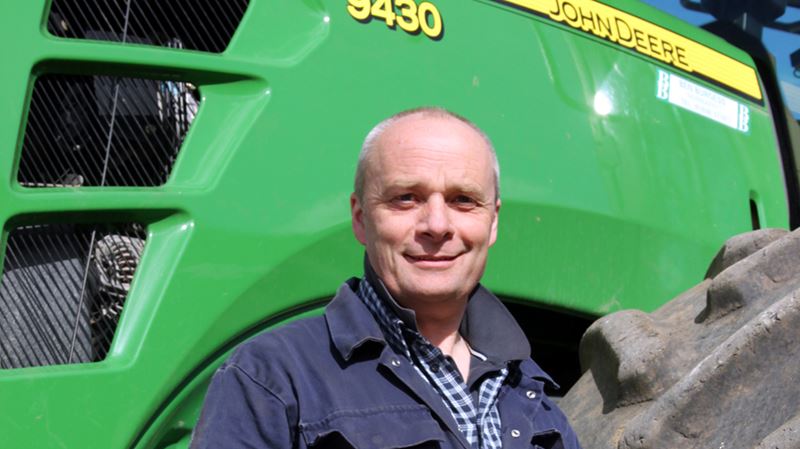Jim Tarry, operator - TB Fairey & Sons

That’s the experience on one Cambridgeshire farm where, with 1,280ha (3,200ac) of wheat and OSR established on its own and neighbouring ground last autumn, its decision to replace one of its two high-hp conventional tractors with a wheeled artic rather than a crawler proved the right one despite the difficult conditions.
At least £50,000 purchase price difference between a rubber-tracked tractor and a similarly-powered machine on wheels, plus additional running and maintenance costs, means a crawler has to offer a farm a significant advantage to justify the investment. For TB Fairey & Sons Ltd, who farm 1,600ha (4,000ac) around Linton, near Cambridge, the decision to purchase a high-hp wheeled artic rather than a tracklayer has been backed by the machine’s performance in one of the wettest autumns on record. But the tractor’s success was as much about tyre choice and advice as the machine itself, believes operator Jim Tarry.
“We carry out cultivations and drilling in conjunction with a neighbour, and had been running two conventional John Deeres, an 8520 and an 8335, as our main tractors,” he explains.
“Our ground is a wide range of boulder clay, flinty chalk and light land, and we establish our oilseed rape and first wheat using minimum tillage, but plough for sugar beet, winter barley and second wheat.”
In order to improve the output of operations on its own land and that of the neighbouring farm, TB Fairey & Sons five years ago renewed its two main tractors. While one made way for a similar but newer and larger 8 series John Deere, it was decided that, in order to increase daily workrates, the other would be replaced with one of the largest machines on the market, a 480hp 9430.
While there had been some interest in switching to a tracked machine, Mr Tarry is convinced that the business’s owners made the right decision. But ensuring the tractor is on the right tyres at the right pressures, and is weighted properly, has been key to its success, he believes.
“When the farm owners were considering buying the tractor, John Deere advised us that, to get the power to the ground, it would be best equipped with dual Goodyears, but after consulting with Treadfirst, our local agricultural tyre supplier, they suggested we talk to Neil Sharman at Trelleborg, who could advise us on other, more practical options for this type and size of tractor.
“His advice was that, with 900/60 R38 TM900s, we could achieve the balance of pulling power and flotation we were looking for. We’d had Goodyears on one of our other Deeres, and hadn’t been that impressed with their performance, so we were keen to try the Trelleborgs, particularly as the tread design, with its wide lug ends, looked like it would put more power to the ground.”
The tractor works with a 6m Gregoire Besson Helios one-pass cultivator, 10f Gregoire Besson articulated plough and seven-leg Tim Howard subsoiler, plus a 6.5m Vaderstad Rexius Twin press, run in conjunction with a Guttler press on the tractor’s Degenhart front linkage to help level and fill holes in ploughed land. Mr Tarry reckons this further improves the tyres’ travel on soft ground, and is probably worth two gears in terms of forward speed.
At 3.2m wide, the 9430 does require an escort for road travel, but this is never more than four miles, and the machine is far narrower than it would be on duals, and more comfortable to drive on the road than a crawler would be, reckons Mr Tarry.
“Although we have some stony ground, the fronts have done 2,750hrs, and should have at least another 1,000hrs in them. You need weight to pull weight, and on Trelleborg’s advice we specified the tractor with a full set of wheel weights, while this year we also ran a one-tonne block on the front linkage when not using the press. The tractor comfortably operates the 6m Helios at 8.5-10km/hr down at 11in, and there’s plenty of traction.”
“Last year we had 1,200 acres of rape drilled by August 25, and 2,000 acres wheat sown by October 22, which shows how well the tyred tractor coped with the conditions. Neil’s advice was invaluable in getting the tractor’s power to the ground, and altering the tyre pressures to suit the weight distribution of the tractor in work, so that the fronts are slightly firmer than the rears, meant that wheelslip was as low as eight per cent at times. With the front press firming the ground, the tyred tractor travelled well, and left behind a good finish for the drill without the headland smearing and compaction that crawlers can create in these sorts of less than ideal conditions.”